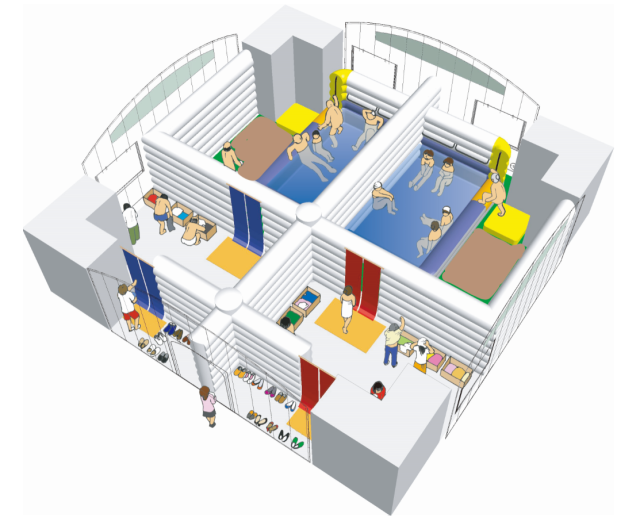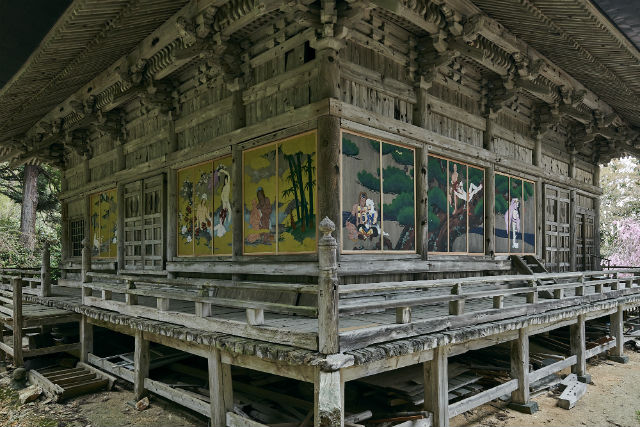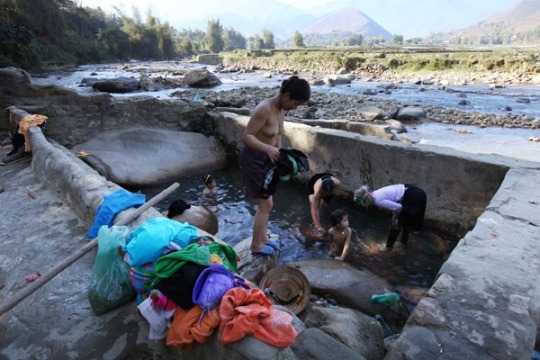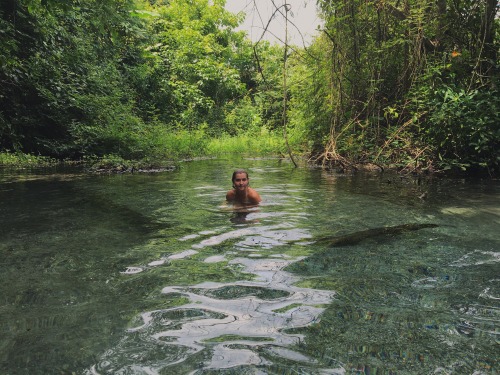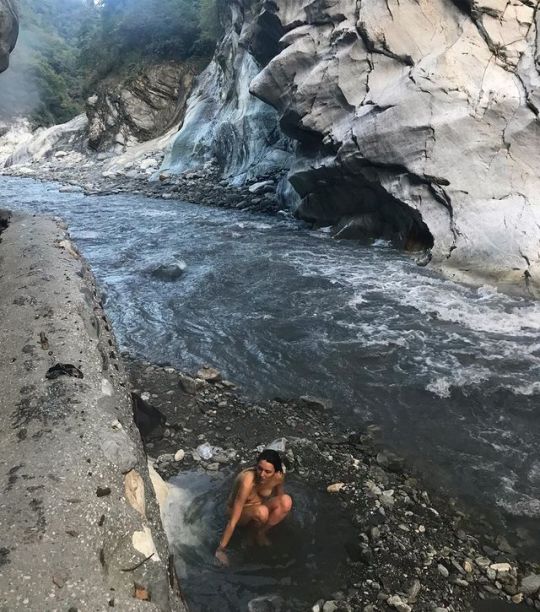Stay wild and freeModel by @rachel_loudy•Fyi tempat ini cocok banget buat list tempat liburan kalian saat tahun baru, tempatnya buat memanjakan badan dan pikiran karena disini kalian bisa berendam dengan air panas, kalau ada yang tahu tempatnya komen ya dibawah guys
But some content.
Secret Retreats (Sep. 28) has a feature on Asian hot springs.
On Rinjani (Lombok, Indonesia):
'Take a trek to the emerald jungles of Mount Rinjani National Park to see Lombok’s wealth of waterfalls and then relax those tired muscles post trek with a soak in the island’s most famous hot spring, ‘Aik Kalak Pengkereman Jembangan’. Aik Kalak translates as boiling water and as the name suggests, it is a place where one can enjoy bathing in the warm, healing waters surrounded by nature. Aside from bathing, local people have long come to the site to perform rituals and seek blessings. Long considered a magical place, locals still today bring ritual items such as Keris (a dagger typically used in religious rituals) to the spring to wash and bless them and ensure their supernatural powers are intact. Legends have it that Sasak warriors, the Sasak are an ethnic group that calls Lombok home, would visit the spring to bathe after battles and the magical waters would heal battle wounds.Aik Kalak Pengkereman Jembangan is located at about 2,000m elevation on the side of Mount Rinjani and in the late afternoon and evening the cooling air makes for a wonderful contrast to the steaming waters of the spring. The refreshing atmosphere of the stunning natural scenery on Mount Rinjani and the warm, healing waters of the hot spring are guaranteed to soothe and revive all who visit.
Thailand, February 2019.🍃🌞Sometimes I feel like I forget to breathe. Not metaphorically speaking, but quite literally holding onto a breath I must remind myself to release.Like there are so many tabs open in my brain I’m not present in the moment. I’ve never been an anxious person. But the last few years have been weird as hell and have brought on more anxiety and stress than ever before.I’ve found comfort in my friends and family, holding them close, practicing yoga and meditation, being in nature, immersing myself in things that bring me joy and calmness. Finding beauty in the small things and focusing on how I can create a life of love, happiness and allow it to overflow to the collective. We all need more kindness in community as well as solitude; doing the inner work. I hope today brings you simply peace. 🙏🏼🦋💛
'Hot Springs are a treat to the eyes and souls of people who genuinely admire the beauty of nature.The city of Pai has some really beautiful Hot Springs that you must check out on your visit here.We have picked up the best ones for you in this blog'.
'The hot springs were the specific reason that I travelled to Kanchanaburi province. I’d been suffering some groin pain for nearly two months after a bad bout of Covid and couldn’t find any way to get rid of it. But when I spent a couple of days at a saline hot spring in Krabi in southern Thailand, I discovered that the pain had more than half disappeared....Wat Wang Khanay Hot SpringThis very traditional public sulphur hot spring is located in a temple complex on the south-eastern side of Kanchanaburi city. It’s very conveniently located to the city – only about 15 km away – but it is unlikely to appeal to most international visitors. You’ll be invited to step into a large stainless-steel drum that looks like an industrial cooking vat after the attendant has filled it with hot water from the underground spring. There are several rows of the vats along one side of the temple courtyard'.
'I had quite a long soak in the coffee pool, but it wasn’t my favourite. The next one was – the eucalyptus pool at No 13. This also claimed to help with blood circulation and skin detoxification, but I so loved the aroma. I could have soaked in this one all day. The temperature was probably only around 38-39°C so you can certainly spend longer in it if there are not too many other people at the hot spring.That was the last pool that I spent much time in because No 14 was only straight mineral water at 38°C. It wasn’t labelled but I assume it was a ‘cooling down’ pool before the last pool which was labelled ‘normal temperature’. That is the largest of all the pools at the hot spring, but I didn’t get to try it because it was being cleaned on the day I was there'.
'A TikTok video posted by a Japanese tourist complaining about “inequality” at a Krabi hot spring after having to pay an entrance fee 10 times the amount locals are charged went viral overnight, with many netizens having their say on Tuesday. The man posted the video after he visited Klong Thom hot spring, where he was charged a 200-baht entry fee as opposed to 20 baht for Thai visitors.“A Japanese [tourist] feels the inequality in Thailand. I had to pay 200 baht while Thais pay only 20 baht,” he complained'.
“The number of hot springs known for their healing benefits has changed from time to time, but not all hot springs possess the properties to help alleviate physical and mental ailments. Thailand is blessed to have a remarkable and curative hot spring located in Klongtom district of Krabi province. Aside from its properties to treat poor mental health and unfavourable physical conditions, the hot spring is also unique for its naturally sparkling saline water.The Klongtom Salt Hot Spring is considered one of the world’s five best hot springs with mineral saltwater following those previously found in Taiwan, Japan, Italy, and Malaysia.”The above explanation was given by Dr Jiroch Sinthawanon, a former senior expert of the Office of Permanent Secretary, the Ministry of Public Health, when conducting a research study on hot springs in Thailand.The publication, named “Safe and Healthy Hot Spring Bath”, was aimed at disseminating knowledge on the use of hot springs to create a good image where people can fully trust their benefits and safety, and maximise the standard of health tourism.Jiroch added that “the temperature and minerals found in the Klongtom Salt Hot Spring are truly outstanding. The seawater seeps into the basement of the hot spring through rock layers to be filtered twice. As a result, the water retains only a light taste of salt unlike the strong salty taste of seawater as well as the smell of sulphur.”
'Wichai [Wichai Poolworaluk, president of Woraluk Property Plc, a leading real estate company in Thailand and a major developer of the Klongtom community in Krabi] said, “As a real-estate leader, we want to be the one to transform people’s concerns into happiness backed by our standardised and trusted management. This had initially inspired us to work on the development of the Klongtom Heritage project. Situated on a vast area of over 200 rai (32 hectares), ...'.
'The local residents will be offered greater job opportunities and a chance to earn a higher income, while the ecosystem and environment will play a vital role in making the community grow in a sustainable way. This will help people to improve and reinvent themselves, getting ready to upgrade their life to national levels, he said'.
Luckily they'll not to be patronized. Oddly the Bangkok Post (Mar. 2) runs exact the same article.
'Most of the hot springs are small, but there are a handful that have been turned into proper resorts and parks'.
Just 45 mins from Kuching's city centerLies an all natural hotspringWhich is reputed to cure diabetes, hypertension etcDamn....doctors are gonna be out of jobsI do so miss the good old daysWhen the responsibility and stress of work was manageable....Maybe all I need is another long relaxing hot bath surrounded by lush greenery#malaysiatrulyasia #malaysiatourism #nature #naturephotography #siasitoksarawak #raonraonsarawak #sarawaktravel #sarawaktourism #sarawakmoretodiscover #amazingborneo #borneo
'Complete with warm lighting, a single-sized tub filled with hot water and imported salts, a shower area, and Urban Retreat’s very own line of toiletries at your disposal, you will want for nothing but some peace and quiet once the 45-minute session begins'.It's a trend getting more and more traction in the area. Is it the culture (here fakely presented)? Is the not need to head to Japan for the experience? Do onsens balance out the hectic city life? I have no idea.
But here are some more snippets concerning onsen experience in the region.
'What if we tell you that you can have an authentic onsen experience right in the bustling city of Bangkok?
'The Onsen mineral water bath uses water from Kanchanaburi’s Wat Wangkanai [sounds familiar?], so enjoy the holistic benefits in the heart of Bangkok'.
VNexpress (Aug. 27) shares an overview of Japanese style hot spring resorts in the Danang region. It's not always clear how the waters are sourced. For instance:
'The resort has a heated swimming pool on the top floor of the 22-story building that allows visitors to admire the entire Da Nang Bay.With a variety of minerals imported from Japan, guests can experience mineral bath services at shared baths or separate areas for men and women'.
Time to relax at Alba Hot Springs. Just a 15 minute drive from the resort!
Wellness Vietnam has an article (Feb. 15) named Best hot springs experience in Vietnam.
'There are more than 200 hot springs throughout Vietnam though only a handful have been developed and are safely accessible for public bathing. Our guide to the ‘Best Hot Springs Experience in Vietnam’ features six unique locations that combine wellness, adventure, and cultural immersion'.
'Tanintharyi region also has natural hot springs and the water is warm and hot in every season. Tanintharyi hot springs are heated groundwater which is of high temperature water. Local people believe that the water of hot springs can be good for our body, relax our muscles and can heal neuralgia. I want to mention four popular natural hot springs among local people in the different areas of the Tanintharyi region'.
'The local edition of famed fashion magazine Vogue has repeatedly been found to be in breach of government content guidelines and, as a result, had its one-year permit revoked yesterday.The magazine then reapplied for a new permit but was granted one lasting just six months.In a Straits Times article, a spokesperson for the Ministry of Communications and Information (MCI) said that Vogue Singapore violated their content guidelines on four occasions within the past two years by including nudity and content that “promoted non-traditional families”.The exact content that violated MCI’s standards has not been revealed. Although Vogue Singapore does not feature explicit nudity, Infocomm Media Development Authority’s content guidelines notes that semi-nude models with breasts or genitals covered by “hands, materials or objects” are also forbidden.As for the part about content promoting “non-traditional” families? That is code for content that portrays queer or LGBTQ+ relationships in a positive light'.
'Un développement touristique incluant un lagon chauffé entre autres par la géothermie et la construction de 300 unités en partie chauffées et climatisées par l’énergie solaire doit prendre forme à 45 minutes de Québec, aux portes du Massif de Charlevoix. Développé en trois phases, l’environnement du GeoLAGON nécessitera un investissement privé de 300 millions'.
Sudah lama sekali ada cita-cita main ke Dieng; baru tahun ini impian itu dapat teraih 💙💚💙💚// Enjoying colourful lakes, ancient temples, meditation caves, hydrangeas and volcanic hot springs in a place I’ve wanted to visit for ages and ages: the beautiful #dieng #plateau in #indonesia. #mountains #lakes #temple #hotsprings
















